|
|
 |
|
|
|
 |
| |
|
|
 |
Weather
Basics |
El Niño, La Niña, global impacts
El Niño
El Niño is a large-scale ocean-atmosphere climate phenomenon in the tropical Pacific, which represents the warm phase of the periodic warming in sea-surface temperatures. It tipically appears around Christmas time (that is why referred as El Niño, which is the Spanish for 'Christ Child') and lasts for several (9-12) months.
|
|
|
|
|
 |
El Niño affecting the world ...
1/a. During the winter of 1997/98, wind-driven waves and abnormally high sea levels significantly contributed to hundreds of millions of dollars in flood and storm damage in the San Francisco Bay region. Recent analyses by U.S. Geological Survey (USGS) scientists of nearly 100 years of sea-level records collected near the Golden Gate Bridge found that these abnormally high sea levels were the direct result of that year’s El Niño atmospheric phenomenon.
from: USGS Fact Sheet
|
 |
|
 |
 |
|
1/b. © Reuters
|
|
 |
More than 35,000 people have been evacuated and nearly 7,000 people remain isolated by the flooding of the Paraguay river. Abnormally heavy rains associated with the El Nio phenomenon have caused flooding affecting 60,000 people in Paraguay's capital , Asuncion, and the provinces of Concepcion, Alberdi, San Pedro, Presidente Hayes and Alto Paraguay.
from: UNDP Desaster Protection, 1998 Jan, 8th
LIMA, 2002 May 9 (AlertNet) - In April, the normally calm Piura River turned overnight into a raging torrent. More than 3,500 families in northern Peru escaped but lost their homes and livelihoods. Scientists disagreed over whether the dramatic weather was connected to the climate phenomenon El Niño, due to make a reappearance this year.
from: Reuters alert net
|
The warm ocean current during El Niño has a big influence on the weather around the globe. The El Niño climatic events can cause increased rainfall, flooding, blustery storms, but also drought and sometimes devastating fires.
What drives El Niño?
During non-El Nino conditions the sea surface temperature (SST) in the tropical Pacific are about 6-8 degrees Celsius higher in the west than in the east. This difference in the temperatures mainly caused by the easterly trade winds, that blow across the tropical Pacific, moving the warm surface water with them from east to west (the surface water becomes progressively warmer going westward because of its longer exposure to solar heating).
|
 |
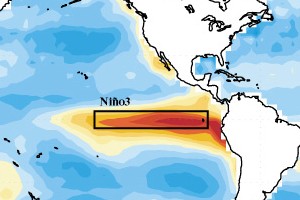 |
 |
|
2. Sea surface temperature anomaly
Please click on the picture above to see a larger view of the sea surface temperature anomaly during an El Niño event. The picture does not tell you, which temperature the ocean has, but it tells you how much warmer (in red) or how much cooler (in blue) the sea is during El Niño compared to the its normal state. As you see west of South America in front of the Peruvian cost, the water is a lot warmer than normal.
© clivar.org / Mojib Latif, MPI Hamburg
|
|
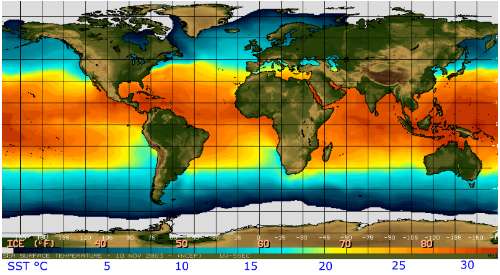 |
 |
|
3. This image shows you the sea surface temperature in absolute values - °Celsius and °Fahrenheit - in November 2003. Click on the image for a higher resolution (130 K)! In front of the South American west coast you see rather cool water from the Humboldt stream. In autumn 2003 there are no El Niño conditions.
source: SSEC University of Madison / Wisconsin
|
The wind blowing the water to the west is why the sea surface is about ½ meter higher at Indonesia than at Ecuador, and, because of this difference of height, in the east an upwelling of cold water starts from deeper levels to lessen the disparity (figure 4 a). This cool, nutrient-rich sea water is very important in terms of fishing.
[The two figures 4 a+b show a 3D-model of the Pacific Ocean, the American continent on the right, Australia on the left.]
|
 |
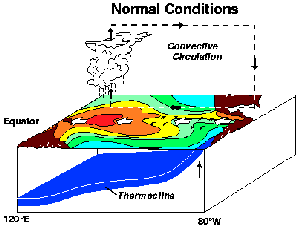 |
 |
|
4. a) Normal conditions in the Pacific
|
|
In contrast, during El Nino years, weakened winds allow warm water to occupy the all tropical Pacific. This of course diminishes the efficiency of the cold water upwelling, and the unexpected warm water resulting in a dramatic reduction in marine fish and plant life. But more importantly this event makes the atmosphere unstable: causes changes in rainfall and weather around the globe.
El Nino episodes occur in every 2-7 years.
|
 |
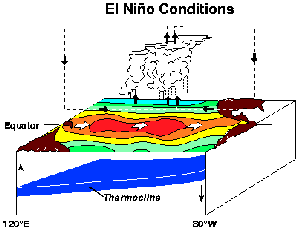 |
 |
|
4. b) El Niño conditions in the Pacific
source: http://www.pmel.noaa.gov
|
|
|
La Nina
Compared to El Nino, La Nina (female child) is defined as cooler than normal sea-surface temperatures in the central and eastern tropical Pacific ocean.
|
During La Niña, the easterly trade winds strengthen and cold upwelling along the equator and the West coast of South America intensifies. Sea-surface temperatures drop as much as 4 degrees C below normal. The event also called anti-El Nino, or simply "a cold event" or "a cold episode". La Nina makes the atmosphere very stable, and tends to cause nearly opposite climatic effects from El Nino.
The phenomenon occurs roughly half as often as El Nino.
|
 |
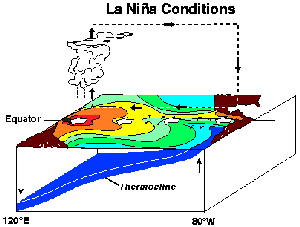 |
 |
|
4. c) La Niña conditions in the Pacific
source: http://www.pmel.noaa.gov
|
|
|
Between 1950 and 1997, El Ninos were present 31%, La Ninas 23% of the time, and about 46% of the period was in a neutral state. El Nino and La Nina occur on average every 3 to 5 years. Based on the historical record, the interval between events has varied from 2 to 7 years. Since 1975, La Ninas have been only half as frequent as El Ninos, therefore, a La Nina episode may, but does not always follow an El Nino. La Nina conditions typically last approximately 9-12 months, but some episodes may persist for as long as two years.
La Nina received its publicity later, than El Nino, because its influence on fisheries is more benign rather than destructive, so La Nina received little attention there. Researches increased after its wider impacts in the 1980s.
|
|
The global impacts of El Nino and La Nina
The global impact of the El Nino and La Nina events are mostly around the basin of Pacific ocean and along the Equator. Roughly, the impacts of these events are contradictory. Figures above and below show the effects of La Nina and El Nino on temperature and precipitation.
|
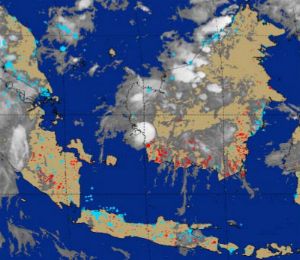 |
 |
|
6. Fires in Indonesia - Sept. 30th, 1997
The strong El Niño event from mid 1997 to mid 1998 has favoured the fire catastrophy in Indonesia in this year.
© NOAA / significant event imigary
|
|
 |
Within the tropics, the eastward shift of thunderstorm activity from Indonesia into the central Pacific during warm episodes results in abnormally dry conditions over northern Australia, Indonesia and the Philippines in both seasons. Drier than normal conditions are also observed over southeastern Africa and northern Brazil, during the northern winter season. During the northern summer season, Indian monsoon rainfall tends to be less than normal, especially in northwest India where crops are adversely affected. Wetter than normal conditions during warm episodes are observed along the west coast of tropical South America, and at subtropical latitudes of North America and South America.
|
|
During a warm episode winter, mid-latitude low pressure systems tend to be more vigorous than normal in the region of the eastern North Pacific. These systems pump abnormally warm air into western Canada, Alaska and the extreme northern portion of the contiguous United States. Storms also tend to be more vigorous in the Gulf of Mexico and along the southeast coast of the United States resulting in wetter than normal conditions in that region.
There is no one clear, similar to the above mentioned impact detected in Europe, yet. It does not mean, that El Nino and La Nina do not influence the weather in Europe, but the connection between these processes is not so strong.
|
About this page:
author: Vera Schlanger - Hungarian Meteorological Service
scientific reviewing: Dr. Ildikó Dobi Wantuch / Dr. Elena Kalmár - Hungarian Meteorological Service, Budapest
last updated: 2003-10-28 |
|
Further reading:
http://geology.wr.usgs.gov
http://www.cpc.ncep.noaa.gov
http://www.pmel.noaa.gov
http://www.ogp.noaa.gov
http://ww2010.atmos.uiuc.edu
http://www.jpl.nasa.gov
http://www.al.noaa.gov
http://ess.geology.ufl.edu
http://www.elnino.noaa.gov
|
|
 |
|









